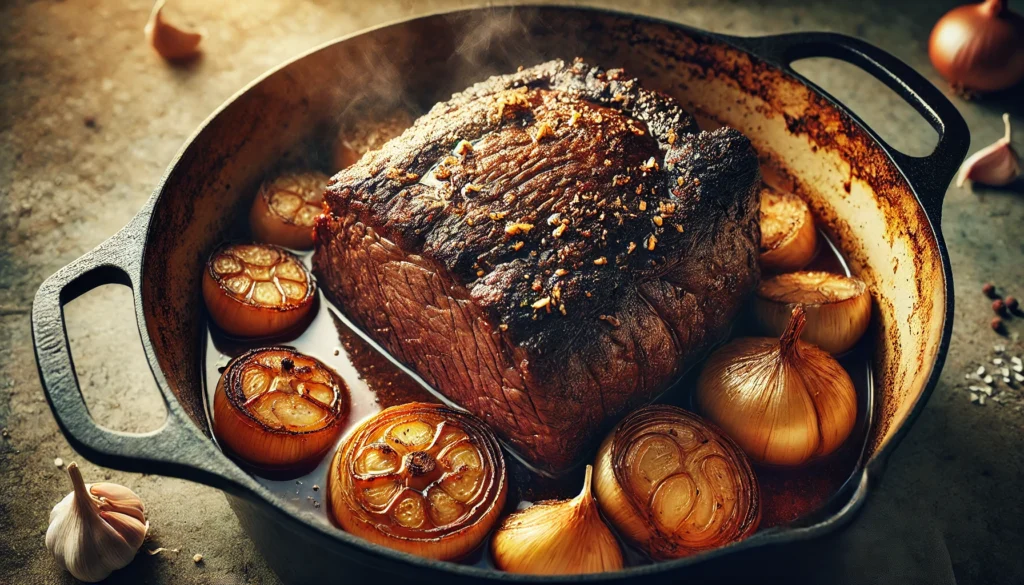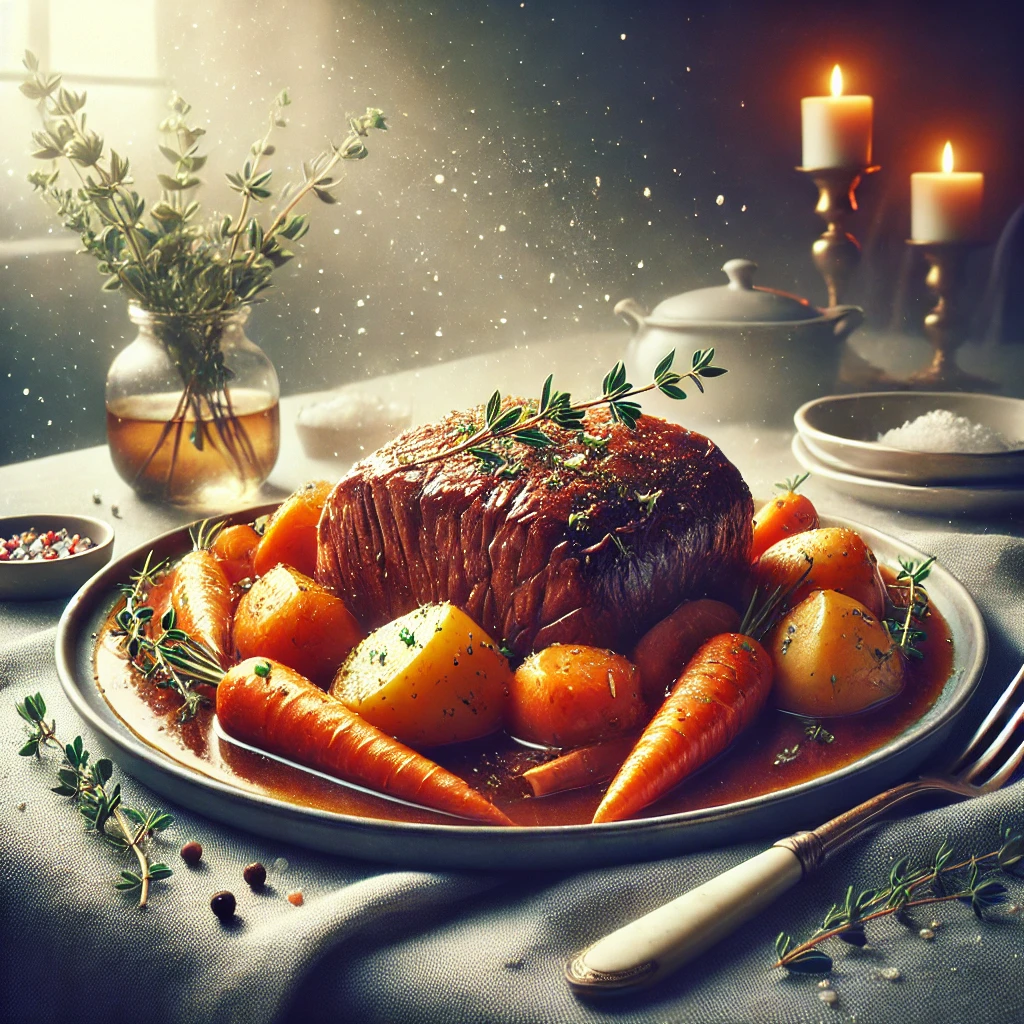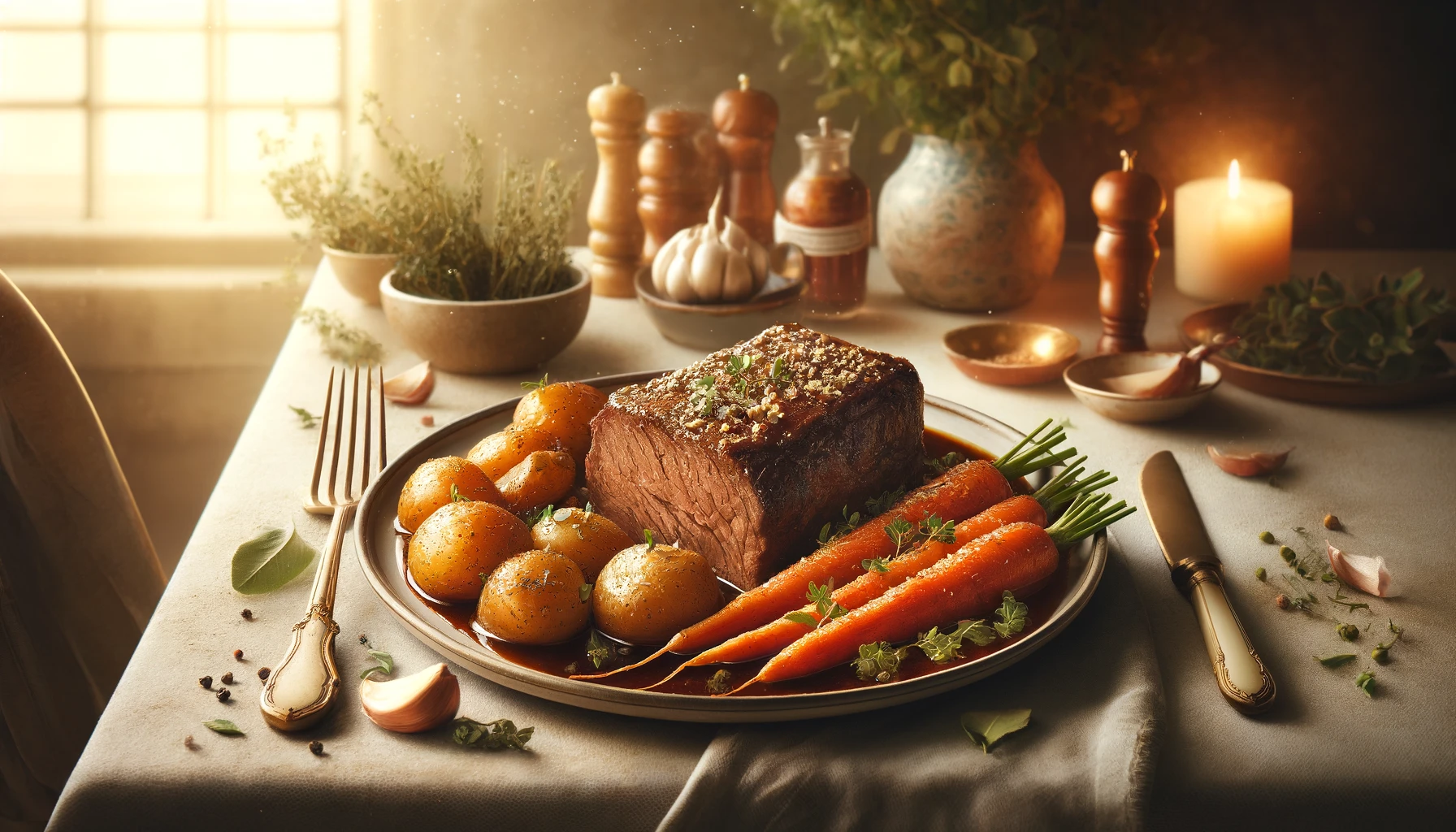Introduction to Classic Pot Roast
What is a Pot Roast
A pot roast is a slow-cooked beef dish, often prepared by braising a tough cut of meat in liquid until it becomes tender and flavorful. The hallmark of this dish lies in its simplicity. By using basic ingredients like beef, vegetables, and broth, you can create a meal that’s both satisfying and deeply flavorful.
The beauty of a pot roast is its versatility. It can be cooked on the stovetop, in the oven, or even in a slow cooker, making it a go-to option for many home cooks. No matter the method, the result is always the same: fall-apart tender meat and perfectly cooked vegetables.
Why is it a Classic Comfort Food
Few meals evoke a sense of nostalgia and warmth like a classic pot roast. This dish has been a staple in family kitchens for generations, often reserved for Sunday dinners or special gatherings. Its rich flavors, hearty ingredients, and slow-cooking process make it a quintessential comfort food.
Moreover, a pot roast brings people together. The savory aroma fills the home, creating an inviting atmosphere that’s perfect for sharing with loved ones. For many, it’s a reminder of cherished moments around the dinner table, enjoying a meal that’s both wholesome and satisfying.
Brief History of the Pot Roast Recipe
The origins of pot roast can be traced back to European cooking traditions, where braising was a common technique for tenderizing tough cuts of meat. Immigrants brought this method to America, adapting it to include local ingredients like beef and root vegetables.
Over time, pot roast became a cornerstone of American cuisine, particularly in the Midwest, where cattle farming was prevalent. Recipes were passed down through families, often evolving to include personal touches and secret ingredients. Today, learning how to make a classic pot roast is a rite of passage for home cooks, preserving a tradition that continues to delight taste buds and warm hearts.
Ingredients Needed for a Classic Pot Roast
Essential Cuts of Meat for Pot Roast
Choosing the right cut of beef is the first step in learning how to make a classic pot roast. For best results, opt for a chuck roast. This cut is well-marbled, ensuring the meat stays tender and juicy during slow cooking. Brisket and bottom round are also excellent choices, especially if you prefer leaner cuts.
For added flavor, consider using a bone-in roast. The marrow from the bone enriches the braising liquid, resulting in a richer, heartier dish. Regardless of the cut, aim for a roast weighing 3 to 5 pounds, as this size is ideal for feeding a small group while leaving enough for leftovers.
Vegetables and Aromatics for Maximum Flavor
No pot roast is complete without its classic companions: vegetables and aromatics. Carrots, potatoes, and onions are staples that not only add texture but also absorb the savory juices, making them incredibly flavorful. For variety, try adding parsnips, celery, or turnips.
Aromatics like garlic, rosemary, and thyme elevate the flavor profile of your roast. These ingredients infuse the broth with earthy, fragrant notes that complement the beef perfectly. Adding bay leaves can further deepen the flavors, while a dash of Worcestershire sauce gives the dish a tangy kick.
Broth Stock or Wine Liquids for Braising
The liquid you choose for braising plays a vital role in how to make a classic pot roast. Beef broth or stock is the traditional choice, providing a savory base that enhances the meat’s natural flavors. For a more complex taste, consider substituting part of the broth with red wine. This not only adds depth but also helps tenderize the meat.
When using wine, be sure to deglaze the pot after searing the meat. Pour the wine into the hot pan and scrape up the browned bits, which hold a lot of flavor. Alternatively, a mix of broth and tomato paste can create a rich, hearty sauce perfect for braising.
Step by Step Instructions for Cooking a Pot Roast

Preparing the Meat
Mastering how to make a classic pot roast starts with properly preparing the meat. Begin by patting the roast dry with paper towels; this helps create a better sear. Next, season it generously with salt, pepper, and your preferred spices, such as garlic powder or paprika.
Heat a large Dutch oven over medium-high heat, then add a few tablespoons of oil. Once the oil shimmers, sear the roast on all sides until it develops a deep, golden-brown crust. This step is crucial for locking in the juices and building a foundation of rich flavors.
Creating a Flavorful Base
After searing the roast, set it aside and use the same pot to prepare the base. Toss in chopped onions, garlic, and celery, cooking them until they’re softened and fragrant. Scrape the bottom of the pot to lift the flavorful browned bits, which will dissolve into the broth, enriching the dish.
Once the vegetables are ready, deglaze the pot with beef broth or red wine. Let the liquid simmer for a few minutes, allowing it to reduce slightly. This process concentrates the flavors and forms the perfect base for braising.
Braising the Pot Roast
Now, the heart of how to make a classic pot roast begins: the braising. Return the seared meat to the pot, nestling it into the aromatic base. Add enough liquid to cover about two-thirds of the roast, ensuring it stays moist throughout cooking.
Cover the pot tightly with a lid and transfer it to a preheated oven set to 325°F (163°C). Allow the roast to braise for 2 to 3 hours, depending on its size. Check it occasionally and turn the meat halfway through to ensure even cooking.
Adding Vegetables and Final Cooking Time
About 45 minutes before the roast is done, it’s time to add the vegetables. Arrange the carrots, potatoes, and any additional veggies around the meat. Ensure they’re partially submerged in the liquid so they can soak up the savory flavors.
Continue cooking until the vegetables are tender and the meat is so soft it falls apart with a fork. Once done, let the pot roast rest for a few minutes before serving. This short resting period allows the juices to redistribute, ensuring every bite is as delicious as the last.
Tips for Perfecting Your Pot Roast

How to Achieve Tender Juicy Meat
The secret to achieving tender, juicy meat when learning how to make a classic pot roast lies in low-and-slow cooking. Using a heavy pot like a Dutch oven helps evenly distribute heat, ensuring the roast cooks thoroughly without drying out.
Additionally, searing the meat before braising creates a crust that locks in the juices. Don’t skip this step, as it adds depth and richness to the overall flavor. To further enhance tenderness, make sure the braising liquid covers two-thirds of the roast, and maintain a steady cooking temperature.
Common Mistakes and How to Avoid Them
Avoid overcooking or under-seasoning your pot roast, as both can significantly impact the final result. Overcooking leads to dry, stringy meat, while under-seasoning leaves the dish bland. Taste the braising liquid periodically and adjust the seasoning if necessary.
Another common mistake is skipping the resting period. After cooking, let the roast rest for 10–15 minutes before slicing. This allows the juices to redistribute, ensuring each bite is moist and flavorful.
Flavor Enhancements Herbs and Spices
Adding fresh herbs and spices can transform a good pot roast into a great one. Rosemary, thyme, and bay leaves are classic choices, while a pinch of smoked paprika or cumin can introduce subtle new layers of flavor. Don’t forget to garnish with fresh parsley for a pop of color and added freshness.
For more hearty recipes, check out Steps to Cook Traditional Meatloaf on Vivid Meals.
Serving and Presentation Ideas
Side Dishes to Pair with Pot Roast
A classic pot roast pairs beautifully with a variety of sides. Creamy mashed potatoes are a timeless favorite, perfect for soaking up the rich, savory gravy. Alternatively, consider serving with buttered egg noodles, roasted asparagus, or a simple green salad to balance the richness of the roast.
For a slightly sweet touch, serve with honey-glazed carrots or maple-roasted butternut squash. These sides complement the savory flavors of the roast, creating a well-rounded meal.
Plating Techniques for a Homestyle Meal
Presentation can elevate your pot roast from a casual family dinner to an impressive centerpiece. Serve the sliced roast on a large platter, surrounded by the colorful vegetables and topped with a ladle of rich gravy.
For an added touch, garnish with fresh herbs like rosemary or thyme sprigs. Using a rustic wooden board or a neutral-colored serving dish enhances the homestyle aesthetic, making your meal visually as well as gastronomically satisfying.
FAQs About Making a Classic Pot Roast
Can You Make a Pot Roast Without a Dutch Oven
Absolutely! While a Dutch oven is a popular choice, you can still learn how to make a classic pot roast using other tools. A slow cooker is an excellent alternative, as it allows the roast to cook gently over several hours, ensuring tender results. Simply follow the same steps for searing the meat and preparing the braising liquid, then transfer everything to the slow cooker.
If you don’t have a slow cooker, a large, oven-safe pot with a tight-fitting lid works just as well. For those who prefer quicker results, an Instant Pot can braise meat in a fraction of the time, though the flavors may be slightly less developed compared to slow cooking methods.
What is the Best Cut of Meat for Pot Roast
The best cuts for a pot roast are those that benefit from slow, moist cooking methods. Chuck roast is the top choice because of its marbling, which keeps the meat moist and flavorful as it braises. Brisket and bottom round are also great options, offering slightly leaner but still tender results.
When selecting your cut, look for one that’s fresh and has visible marbling throughout. This ensures a juicy and flavorful roast, perfect for mastering how to make a classic pot roast.
How Long Should a Pot Roast Cook
Cooking time depends on the size and type of meat. Generally, a 3–5 pound roast will take about 2.5 to 3 hours in the oven at 325°F (163°C). Slow cookers require 8–10 hours on low heat or 4–5 hours on high heat. If using an Instant Pot, the cook time can be as short as 60–90 minutes.
Regardless of the method, always check for tenderness by piercing the meat with a fork. If the fork slides in easily, your pot roast is ready to serve.
Variations of the Classic Pot Roast
Slow Cooker Pot Roast
One popular variation of how to make a classic pot roast is the slow cooker method. This approach is perfect for busy days when you want a hearty meal without constant attention. Simply sear the meat on the stovetop, then transfer it to the slow cooker along with the vegetables and braising liquid. Set it on low and let it cook for 8–10 hours.
The slow cooker not only ensures the meat is tender but also allows the flavors to meld beautifully. Plus, the convenience of a one-pot meal makes cleanup a breeze.
Instant Pot Method
For those short on time, the Instant Pot offers a speedy alternative to traditional methods. Begin by using the sauté function to sear the meat and cook the aromatics. Then, add the liquid, seal the lid, and pressure-cook for 60–90 minutes, depending on the size of the roast.
The result is a tender, flavorful pot roast in a fraction of the time. While some prefer the depth of flavor that comes from slow cooking, the Instant Pot is perfect for busy weeknights when you still crave a comforting meal.
Regional Twists and Flavor Profiles
Every region has its own spin on the classic pot roast. In the South, you might find pot roast served with grits or collard greens, while Midwestern variations often include root vegetables like turnips or rutabagas. Some cooks add a splash of balsamic vinegar or soy sauce to their braising liquid, enhancing the savory and slightly tangy flavor profile.
Experimenting with herbs, spices, or even adding a tomato-based broth can give your pot roast a unique twist while still staying true to the dish’s comforting roots. These small adjustments allow you to personalize how to make a classic pot roast to suit your taste.
Storing and Reheating Pot Roast
How to Properly Store Leftovers
Knowing how to store leftovers is an essential part of mastering how to make a classic pot roast. Once the meal has cooled, transfer the pot roast and its vegetables into an airtight container. Be sure to include some of the braising liquid to keep the meat moist. Store in the refrigerator for up to 4 days.
For longer storage, you can freeze the pot roast. Place it in a freezer-safe container, again with some of the liquid, to preserve its flavor and texture. Properly stored, frozen pot roast can last up to 3 months.
Reheating Techniques for Best Results
Reheating pot roast correctly ensures it retains its tenderness and flavor. For best results, warm it in the oven. Place the roast and vegetables in a covered baking dish, add a bit of reserved liquid to prevent drying, and heat at 325°F (163°C) until warmed through.
Alternatively, you can reheat smaller portions on the stovetop. Use a saucepan, add a splash of broth or water, and heat over low, stirring occasionally. While the microwave is faster, it’s not ideal as it can dry out the meat.
FAQs About Pot Roast Cooking Techniques
Can You Cook Pot Roast Without Browning It First
Though browning isn’t strictly necessary, it adds depth to the flavor and improves the dish’s overall richness. By skipping this step, you’ll lose some of the savory caramelization that makes a pot roast truly exceptional.
What Can I Use if I Don’t Have Beef Broth
If you don’t have beef broth on hand, you can substitute it with chicken broth, vegetable broth, or even water mixed with bouillon cubes. Red wine or a splash of balsamic vinegar can also enhance the flavor.

